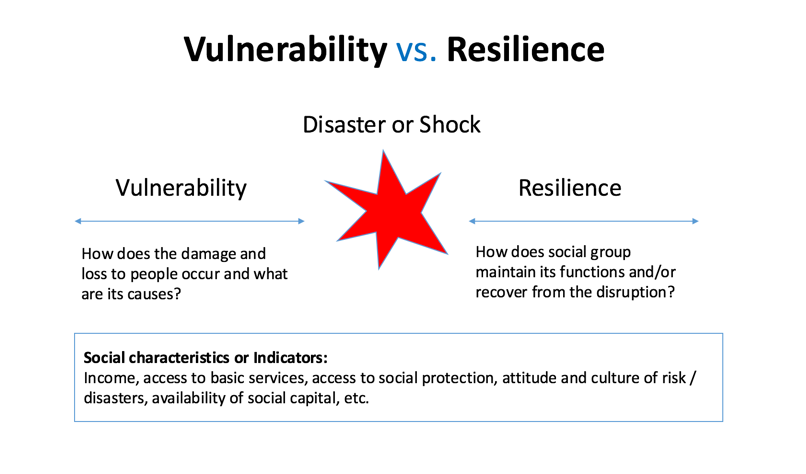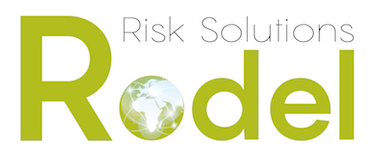Social vulnerability does not have a single uniform definition. Five typical definitions of social vulnerability can been found in the literature:
- Social vulnerability refers to potential harm to people. It involves a combination of factors that determines the degree to which someone's life and livelihood are put at risk by a discrete and identifiable event in nature or society.
- Social vulnerability refers to the characteristics of a person or groupin terms of their capacity to anticipate, cope with, resist, and recover from the impact of a natural hazard (Wisner et al. 2004).
- Social vulnerability refers to the resilience of communitieswhen confronted by external (natural or man-made) stresses on human health. Reducing social vulnerability can decrease both human suffering and economic loss.
[1]
- Social vulnerability refers to the inability of people, organizations, and societies to withstand adverse impacts from multiple stressors to which they are exposed. These impacts are due in part to characteristics inherent in social interactions, institutions, and systems of cultural values.
[2]
- Social vulnerability refers to the susceptibility of social groups to potential lossesfrom hazard events (Hewitt 1997).
These definitions reflect a number of critical issues in the understanding of social vulnerability. First, they mix notions of social vulnerability and resilience. For example, the frequently cited second definition seems more about societal resilience than social vulnerability, while the fourth definition simply includes the notion of resilience as part of social vulnerability. But while they are related, the concepts of social vulnerability and resilience address different characteristics of social groups. Social vulnerability addresses the susceptibility of social groups to potential losses caused by hazard events, whereas resilience reflects the ability of social groups to deal with a disaster or shock. Second, the concept of social vulnerability and resilience is context- and hazard-specific. For example, social groups in one community might be vulnerable to earthquakes, but not necessarily vulnerable to floods. Even within the same community, the vulnerability of social groups may differ depending on groups’ actual exposure. Third, social vulnerability should be distinguished from the specific needs of socially vulnerable groups following a disaster, which arise out of the crisis or disaster itself and are relatively short term.
The correct understanding of the concepts of vulnerability and resilience is critical. As illustrated in figure 1, vulnerability relates to how certain social groups suffer damage and loss; the study of vulnerability aims to explain what makes these groups vulnerable. Resilience on the other hand relates to how social groups maintain their functions or recover from a disruption. The study of resilience uses the same set of social characteristics or indicators as the study of vulnerability (Adapted from Cutter et al. 2003):
- Level of poverty
- Access to resources such as information, knowledge, and technology
- Access to political power and representation (marginalization, exclusion)
- Social capital including social networks and connections
- Social beliefs, customs, and attitude in response to risk or disasters
- Vulnerable residential settings (i.e., weak structure, poor protection, poor maintenance, etc.)
- Presence of frail and physically limited individuals
- Access to critical services such as communication, transportation, power supply, water supply, sanitation, etc.

The study of social vulnerability should explain how certain social characteristics contribute to people’s worsening situation during a disaster. It should explain, for example, why over 70 percent of the dead in Hurricane Katrina were over the age of 65, and why African Americans suffered a disproportionate number of deaths relative to whites and to their local population numbers; why of the 300,000 people killed in the 2004 Indian Ocean tsunami, 240,000 were women and children; and why in the Great East Japan earthquake of 2011, more than half (56 percent) of the victims were aged 65 or older.
To some extent, social vulnerability is the socioeconomic and political root cause of risk and disaster. For example, the elderly are fragile, but age alone does not create vulnerability; vulnerability also arises from society’s failure to recognize that limited mobility impedes timely evacuation. When disaster managers and political leaders fail to design warning systems that reach people who are deaf or to provide paratransit systems to evacuate wheelchair users, society bears responsibility for the consequences. Social vulnerability thus results from processes of social inequality and historic patterns of social relations that manifest as deeply embedded social structures resistant to change.
By Dr. Jianping Yan, Founder & CTO, Rodel Risk Solutions
----------------
[1]
Agency for Toxic Substances and Disease Registry, Social Vulnerability Index, http://svi.cdc.gov/.

Comments
yes
yes